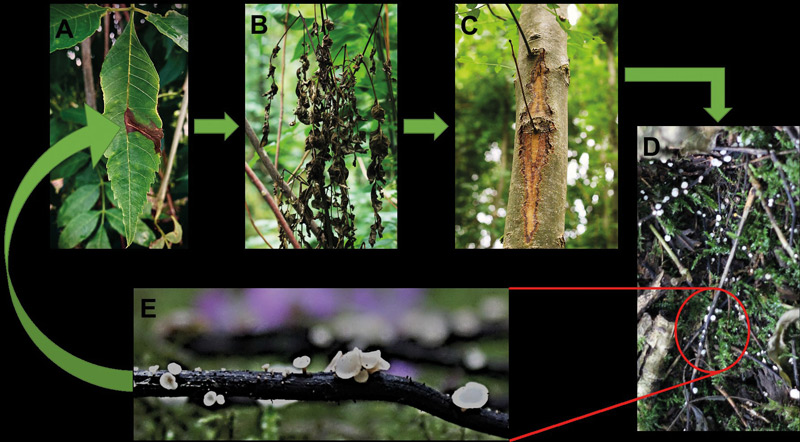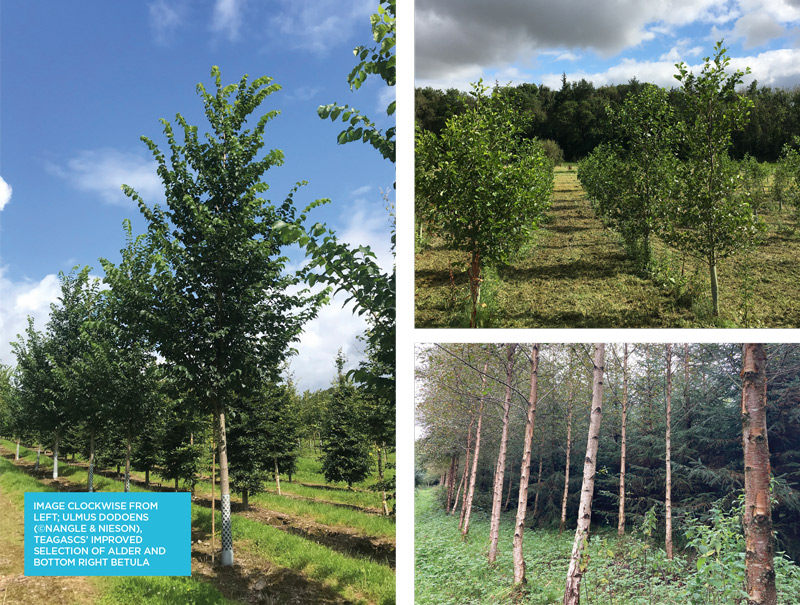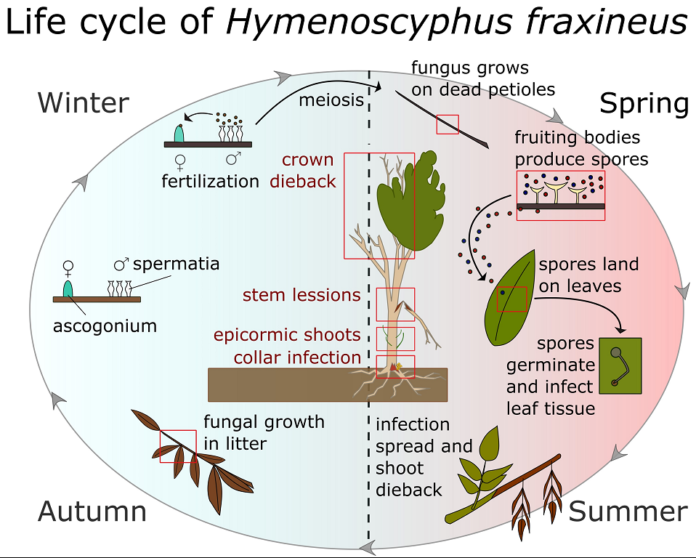European common ash (Fraxinus excelsior; Irish: Fuinseóg) is one of the most important native broadleaf tree species of our hedgerows and traditional woodlands. The species is now under threat from Ash Dieback disease (ADB), caused by the invasive fungal pathogen Hymenoscyphus fraxineus. Ash dieback is a highly destructive disease of ash trees (Fraxinus species), especially the Irish native common ash. The disease causal agent originated in Asia, and was first found in Europe in the 1990’s. In Ireland, the ash dieback was first noticed in 2012. The disease is observed in all counties in Ireland. Symptoms of the disease include leaf death, shoot dieback, diamond shape lesions on branches/tree trunk, and crown thinning eventually resulting in the death of most trees. Ash trees have evolved and co-exist with a native fungus – Hymenoscyphus albidus that also causes dieback of branches, but rarely affects the tree growth and kills the tree. While, Hymenoscyphus fraxineus is a more aggressive fungal pathogen from Asia, and has a more devastating effect on our Irish ash trees, killing the majority of them. Previous research shows that around 1% of the ash population exhibit a higher level of tolerance to this more potent pathogen, and up to 10% of trees show a good level of tolerance. This resistance is controlled by several genes and is heritable from tolerant healthy trees to their offsprings. Therefore, by identifying these healthy ash trees that have a high level of tolerance, we can breed and produce ash genotypes that are tolerant to the disease.
In Ireland, ash dieback was first noticed in 2012. The disease can now be observed in all counties in Ireland
In Teagasc, an ash-breeding programme to develop dieback tolerant genotypes started in 2015. As part of this research work, a field trial consisting of 1000 Irish genotypes was established in Lithuania; a high disease pressure region, to screen and identify dieback- tolerant Irish genotypes. In addition to this, we also established gene-banks comprising 208 ash genotypes from 16 European countries that showed higher levels of tolerance to dieback in their provenances, to study their tolerance and suitability to Irish climatic conditions.
 Preliminary data collected over the last two years from the ash gene-bank in Castlemorris shows that around 28% of the 208 ash genotypes are showing good levels of tolerance to the dieback disease. In addition, around 5% of these ash genotypes exhibit a higher level of tolerance with no sign of dieback to-date. These results are promising and very exciting, however tree breeding is a long term process, thus further testing and screening is required.
Preliminary data collected over the last two years from the ash gene-bank in Castlemorris shows that around 28% of the 208 ash genotypes are showing good levels of tolerance to the dieback disease. In addition, around 5% of these ash genotypes exhibit a higher level of tolerance with no sign of dieback to-date. These results are promising and very exciting, however tree breeding is a long term process, thus further testing and screening is required.
In Teagasc, we are working with national and international partners to identify, select, screen phenotypically, genetically, and monitor healthy ash trees for disease tolerance to breed ash genotypes that are productive and future-ready for climate change. In addition, we are collecting seeds from healthy trees to grow them and screen for disease tolerance at seedling stage. With this work, we aim to identify a diverse and large number of ash trees with good tolerance levels to ash dieback at an early stage. The selected healthy trees will be further screened for tolerance in two different ways; via molecular fingerprinting, and directly through controlled inoculations.
Moreover, research is focused on developing vegetative micropropagation techniques to rapidly multiply the tolerant genotypes for further testing under field conditions and in multiple locations. We also have an indoor seed orchard established this year consisting of 28 ash genotypes that show a good level of tolerance. The seed from these trees will be harvested to sow, grown seedlings and screen for the dieback disease tolerance and other resilient traits.
The long-term aim of this work is to multiply these tolerant genotypes to establish clonal seed orchards, seedline seed orchards and continue field-testing the clones and their progeny to restore ash in the Irish landscape.
The Teagasc ash breeding research is conducted in collaboration with national and international partners along with Coillte and the Office of Public Works to establish multiple gene banks and field trials of tolerant ash across Ireland. The Department of Agriculture, Food and the Marine (DAFM) continues to support the research work on ash breeding and genetic conservation led by Teagasc.
 You can find all our information on Ash Dieback here https://bit.ly/-ashdieback or scan the link to watch a short video of breeding work and research we are undertaking to develop a better strong Ashtree fit for the Irish environment.
You can find all our information on Ash Dieback here https://bit.ly/-ashdieback or scan the link to watch a short video of breeding work and research we are undertaking to develop a better strong Ashtree fit for the Irish environment.

DR DHEERAJ RATHORE is a tree improvement researcher at Teagasc, Forestry Development Department. He is leading the Teagasc ash breeding programme to breed genotypes that are highly tolerant to dieback disease, productive and adapted for the changing climate. He can be contacted at Dheeraj.Rathore@teagasc.ie.
TREE SELECTION IN A CHANGING LANDSCAPE
Dónall Flanagan selects some options for Ash replacement for nursery stock growers and landowners.

BIRCH – BETULA
These trees are hardy pioneer species native to Ireland. A wide selection of ornamental varieties are available including the Irish bred ‘Spider Alley’. An improved selection of native Irish birch has been developed by Teagasc and are commercially available. Birch thrive where there is an adequate level of moisture.
ALDER ALNUS
Alder Alnus trees is well recognised for use in shelter belts but their robust nature makes them versatile for use in urban and more natural settings. Most species prefer a slightly damp site but A. rubra and A. incana laciniata will tolerate dry sites, Alnus spaethii is a very popular conical street tree. Teagasc has been active in breeding improved selections of A. glutinosa since 2014
SYCAMORE
Acer pseudoplatanus is another robust tree tolerant of exposed sites. It supports honey bees and pollinating insects due to the honey dew produced by aphids. Sycamore is a large tree suited to farms, parkland and avenues but selections such as Negenia and Simon Louis Freres make excellent street and garden trees.
ELM – ULMUS
With native elms almost entirely wiped out over 40 years ago due to Dutch Elm Disease, a wide selection of tried and tested varieties are now available. Some of the most resistant varieties include; Dodoens, Pioneer, Homestead, Resista New Horizon and Reboona. They are also tolerant of exposed sites and salt laden wind.
HAWTHORN – CRATAEGUS
Possibly the hardiest of our native trees, they are at home in hedgerows and as solitary trees. Their flowers are a great nectar source for bees followed by red berries in the Autumn. Varieties such as C. x lavalleei ‘Carrierei’, C. pinnatifida ‘Big Ball’ and Pauls Scarletts are attractive garden trees. C. punctata ‘Ohio Pioneer’ is suitable as a street tree. The single flowered Crataegus succulenta ‘Jubilee’ is also highly resistant to Fireblight. ✽






